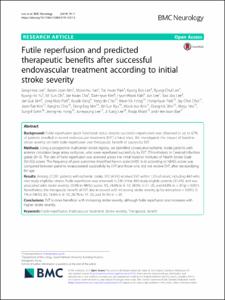Futile reperfusion and predicted therapeutic benefits after successful endovascular treatment according to initial stroke severity
- Keimyung Author(s)
- Sohn, Sung Il; Hong, Jeong Ho
- Department
- Dept. of Neurology (신경과학)
- Journal Title
- BMC Neurology
- Issued Date
- 2019
- Volume
- 19
- Issue
- 11
- Abstract
- Background:
Futile reperfusion (poor functional status despite successful reperfusion) was observed in up to 67% of patients enrolled in recent endovascular treatment (EVT) clinical trials. We investigated the impact of baseline stroke severity on both futile reperfusion and therapeutic benefit of successful EVT.
Methods:
Using a prospective multicenter stroke registry, we identified consecutive ischemic stroke patients with anterior circulation large artery occlusion, who were reperfused successfully by EVT (Thrombolysis in Cerebral Infarction grade 2b–3). The rate of futile reperfusion was assessed across the initial National Institutes of Health Stroke Scale (NIHSS) scores. The frequency of poor outcomes (modified Rankin scale [mRS] 3–6) according to NIHSS scores was compared between patients revascularized successfully by EVT and those who did not receive EVT, after standardizing for age.
Results:
Among 21,591 patients with ischemic stroke, 972 (4.5%) received EVT within 12 h of onset, including 440 who met study eligibility criteria. Futile reperfusion was observed in 226 of the 440 study-eligible patients (51.4%) and was associated with stroke severity: 20.9% in NIHSS scores ≤5, 34.6% in 6–10, 58.9% in 11–20, and 63.8% in > 20 (p < 0.001). Nonetheless, the therapeutic benefit of EVT also increased with increasing stroke severity (p for interaction < 0.001): 0. 1% in NIHSS ≤5, 18.6% in 6–10, 28.7% in 11–20, and 34.3% in > 20.
Conclusions:
EVT is more beneficial with increasing stroke severity, although futile reperfusion also increases with higher stroke severity.
- Publisher
- School of Medicine (의과대학)
- Citation
- Sang-Hwa Lee et al. (2019). Futile reperfusion and predicted therapeutic benefits after successful endovascular treatment according to initial stroke severity. BMC Neurology, 19(11). doi: 10.1186/s12883-019-1237-2
- Type
- Article
- ISSN
- 1471-2377
- Source
- https://bmcneurol.biomedcentral.com/articles/10.1186/s12883-019-1237-2
- Appears in Collections:
- 1. School of Medicine (의과대학) > Dept. of Neurology (신경과학)
- 파일 목록
-
-
Download
 oak-2019-0035.pdf
기타 데이터 / 759.21 kB / Adobe PDF
oak-2019-0035.pdf
기타 데이터 / 759.21 kB / Adobe PDF
-
Items in Repository are protected by copyright, with all rights reserved, unless otherwise indicated.